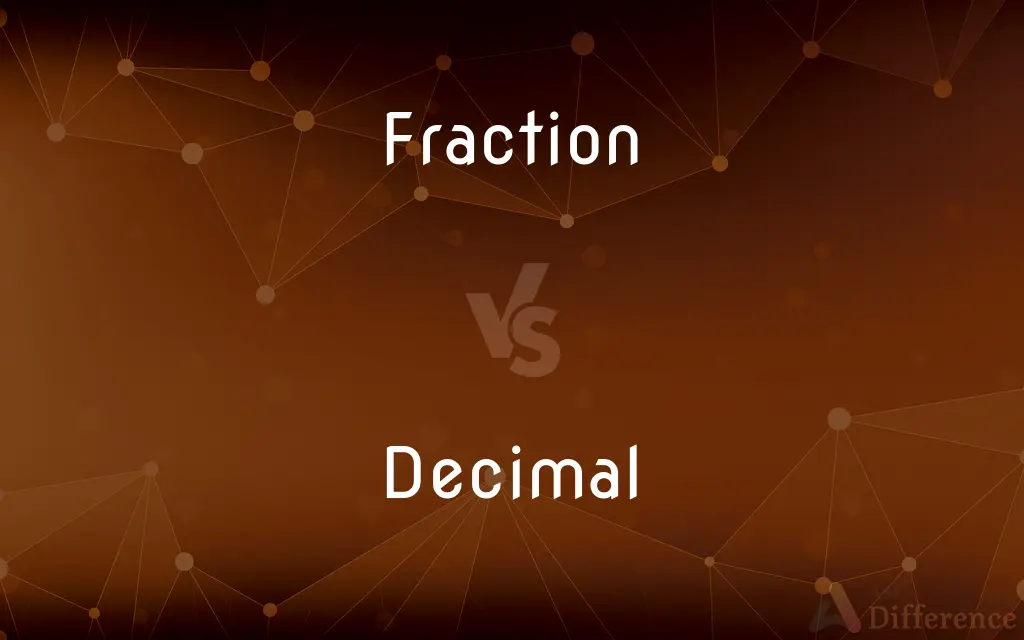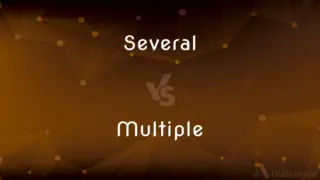Fraction vs. Decimal — What's the Difference?
By Maham Liaqat & Urooj Arif — Updated on April 15, 2024
Fractions represent numbers through a ratio of integers, as in 1/2, while decimals express numbers using a point to separate whole numbers from fractional parts, like 0.5.

Difference Between Fraction and Decimal
Table of Contents
ADVERTISEMENT
Key Differences
Fractions consist of two integers, the numerator and the denominator, where the numerator is divided by the denominator. On the other hand, decimals are a way of writing fractions and other numbers using base ten, where each place value to the right of the decimal point represents a power of ten in the denominator.
A fraction can explicitly show part-to-whole relationships, such as one out of two parts (1/2), making it easy to see proportions directly. Whereas, decimals provide a view of numbers that is often easier to compare at a glance, especially when dealing with hundreds, thousands, or smaller units like tenths, hundredths, etc.
In terms of conversion, any fraction can be converted into a decimal through division, and many decimals can be converted into fractions by understanding the place value. For instance, 0.75 means 75/100, which simplifies to 3/4.
Fractions are often used in contexts where exact ratios are important, such as in recipes or measurements in some engineering applications. On the other hand, decimals are commonly used in financial contexts, science, and any other field that requires high precision for small units.
Mathematically, both fractions and decimals are used to perform arithmetic operations, but the approach can differ significantly. Fractions involve operations with numerators and denominators, possibly requiring finding a common denominator, while decimal operations follow the same basic rules as whole numbers, adjusting for decimal placement.
ADVERTISEMENT
Comparison Chart
Representation
Ratio of two integers
Point separates whole numbers from fractional parts
Ease of Understanding
Shows ratios explicitly
Quickly shows size and scale
Conversion
To decimal via division
To fraction using place value
Common Uses
Recipes, measurements
Finance, science
Mathematical Operations
Requires manipulation of numerators and denominators
Follows rules of whole number operations, adjusting for decimal placement
Compare with Definitions
Fraction
A mathematical expression representing the division of one integer by another.
In the fraction 1/2, 1 is the numerator, and 2 is the denominator.
Decimal
Can simplify the representation of fractions for ease of calculation.
Decimals are preferred in financial calculations to quickly add prices.
Fraction
Expressed using two numbers separated by a slash.
The fraction 3/4 means three parts of a whole divided into four equal parts.
Decimal
Includes digits to the right of the decimal point, each digit representing a power of ten.
In 12.345, the 5 is in the thousandths place.
Fraction
Can represent division operations without performing the actual division.
Fractions are often used in algebra to solve equations without decimal conversion.
Decimal
Can be converted to a fraction by understanding the place value.
The decimal 0.75 converts directly to 75/100 or 3/4 when simplified.
Fraction
Fractions can be simplified by finding the greatest common divisor.
Simplifying the fraction 15/45 results in 1/3.
Decimal
A number expressed in the base-10 system, using a decimal point.
The decimal 0.25 represents a quarter (25/100).
Fraction
Used to denote a part of a whole.
In a pizza cut into 8 pieces, eating 3 pieces is represented as 3/8 of the pizza.
Decimal
Used to represent fractions and real numbers more precisely.
0.333... represents the ongoing division of 1 by 3.
Fraction
(Mathematics) An expression that indicates the quotient of two quantities, such as 1/3 .
Decimal
The decimal numeral system (also called the base-ten positional numeral system, and occasionally called denary or decanary) is the standard system for denoting integer and non-integer numbers. It is the extension to non-integer numbers of the Hindu–Arabic numeral system.
Fraction
A disconnected piece; a fragment.
Decimal
A linear array of digits that contains a single period, called the decimal point, is possibly preceded by a minus sign (-), and represents a real number, with each successive digit to the right of the decimal point indicating a multiple of the next negative power of 10, and each successive digit to the left of the decimal point indicating a multiple of the next non-negative power of ten, beginning with 100 = 1. For example, 245.3 represents the real number (2 × 102) + (4 × 101) + (5 × 100) + (3 × 10-1) = 200 + 40 + 5 + 3/10 , and -1.04 represents the real number (-1 × 100) + (-4 × 10-2). Also called mixed decimal.
Fraction
A small part; a bit
Moved a fraction of a step.
Decimal
Such an array of digits in which there are no nonzero digits to the left of the decimal point, representing a real number between -1 and 1. Also called decimal fraction.
Fraction
A chemical component separated by fractionation.
Decimal
A number written using the base 10.
Fraction
A part of a whole, especially a comparatively small part.
Decimal
Expressed or expressible as a decimal.
Fraction
(arithmetic) A ratio of two numbers (numerator and denominator), usually written one above the other and separated by a horizontal bar called the vinculum or, alternatively, in sequence on the same line and separated by a solidus (diagonal bar).
Decimal
Based on 10.
Fraction
(chemistry) A component of a mixture, separated by fractionation.
Decimal
Numbered or ordered by groups of 10.
Fraction
(Christianity) In a eucharistic service, the breaking of the host.
Decimal
(countable) A number expressed in the base-ten system, (particularly) a fractional numeral written in this system.
Fraction
A small amount.
Decimal
The decimal system itself.
Fraction
(archaic) The act of breaking, or state of being broken, especially by violence.
Decimal
(informal) A decimal place.
Pi has a value of 3.142, to three decimals.
Fraction
To divide or break into fractions.
Decimal
(informal) A decimal point.
Fraction
The act of breaking, or state of being broken, especially by violence.
Neither can the natural body of Christ be subject to any fraction or breaking up.
Decimal
Concerning numbers expressed in decimal or mathematical calculations performed using decimal.
Fraction
A portion; a fragment.
Some niggard fractions of an hour.
Decimal
To represent with numbers after a decimal point.
Fraction
One or more aliquot parts of a unit or whole number; an expression for a definite portion of a unit or magnitude.
Decimal
Of or pertaining to decimals; numbered or proceeding by tens; having a tenfold increase or decrease, each unit being ten times the unit next smaller; as, decimal notation; a decimal coinage.
Fraction
To separate by means of, or to subject to, fractional distillation or crystallization; to fractionate; - frequently used with out; as, to fraction out a certain grade of oil from pretroleum.
Decimal
A number expressed in the scale of tens; specifically, and almost exclusively, used as synonymous with a decimal fraction.
Fraction
A component of a mixture that has been separated by a fractional process
Decimal
A proper fraction whose denominator is a power of 10
Fraction
A small part or item forming a piece of a whole
Decimal
A number in the decimal system
Fraction
The quotient of two rational numbers
Decimal
Numbered or proceeding by tens; based on ten;
The decimal system
Fraction
Perform a division;
Can you divide 49 by seven?
Decimal
Divided by tens or hundreds;
A decimal fraction
Decimal coinage
Common Curiosities
How do you convert a decimal to a fraction?
To convert a decimal to a fraction, identify the place value of the last digit, use it as the denominator (10, 100, 1000, etc.), and simplify if possible.
Why might someone prefer to use a fraction instead of a decimal?
Fractions can be more useful when exact ratios are required or when dealing with wholes divided into equal parts, like in recipes or manual measurements.
What role do fractions and decimals play in mathematics?
Both are fundamental for describing quantities that are not whole numbers, essential in fields ranging from basic arithmetic to complex engineering and scientific calculations.
Can every fraction be converted to a decimal?
Yes, every fraction can be converted into a decimal through division, though some fractions lead to repeating decimals.
Are decimals more accurate than fractions?
Decimals and fractions can both represent numbers precisely; the choice between them often depends on the need for clarity or ease of operation.
Which is more common in daily use, fractions or decimals?
Decimals are more commonly used in daily activities, especially in contexts like shopping, banking, and any kind of scientific calculation, due to their ease of use and clarity.
How does understanding decimals help in real life?
Understanding decimals is crucial for managing finances, measuring distances, adjusting recipes, and any task requiring precise measurement or financial calculation.
What is the historical significance of fractions and decimals?
Fractions have been used since ancient times for trade, measurements, and early mathematics. Decimals became widely used with the introduction of the metric system and the need for more detailed scientific measurements.
What is easier to use, fractions or decimals?
The ease depends on the context; decimals are generally easier for quick calculations and comparisons, while fractions can more clearly show ratios and proportions.
What is a recurring decimal?
A recurring decimal is a decimal in which a digit or group of digits repeats indefinitely, such as 0.333... or 0.142857142857...
How do professional fields utilize fractions and decimals?
Fields like engineering, carpentry, and cooking might prefer fractions for exact measurements, while finance, science, and technology typically rely on decimals for precision and ease of calculation.
Are there any computational tools that prefer fractions over decimals?
Some computational tools and programming environments prefer fractions to avoid the rounding errors associated with floating-point arithmetic in decimals.
Can decimals and fractions be used interchangeably?
They can often be used interchangeably, but the choice depends on the specific requirements for precision or the format preferred in particular fields or cultures.
How do educators teach fractions and decimals?
Educators often introduce fractions first to understand ratios and proportions, then decimals as a way to represent those fractions in a more digestible format.
Which is more challenging to learn, fractions or decimals?
Fractions can be conceptually harder for some students because they involve an understanding of ratios and division, while decimals are straightforward as an extension of the base-ten number system.
Share Your Discovery

Previous Comparison
Several vs. Multiple
Next Comparison
Kms vs. MakAuthor Spotlight
Written by
Maham LiaqatCo-written by
Urooj ArifUrooj is a skilled content writer at Ask Difference, known for her exceptional ability to simplify complex topics into engaging and informative content. With a passion for research and a flair for clear, concise writing, she consistently delivers articles that resonate with our diverse audience.
















































